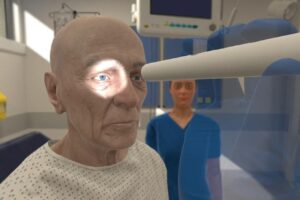Should Healthcare Simulation Follow Aviation & Require Periodic Testing?
The 2021 International Meeting on Simulation in Healthcare (IMSH) clinical simulation presentation titled “Should Healthcare Follow Aviation & Require Periodic Testing” described how to integrate aviation concepts and techniques into healthcare simulation for ongoing, periodic, summative evaluation and training. Authored by Teresa Gore, Tim Whitaker and Andrew Spain, the healthcare simulation presentation also compared and contrasted the aviation and medical simulation constructs, summarizing the potential positive and negative impacts of healthcare requiring periodic simulation evaluation to maintain licenses and certifications. Here, Dr. Kim Baily provides an informative review of the healthcare simulation presentation, noting how more transparency in reported data is needed across medicine.
When the first Boeing 737 Max 8 crash in October 2018 was followed by a second crash on March 10, 2019, governments around the world suspended 737 Max operations. Three hundred and forty six souls lost their lives. The world’s press quickly reported the crashes and the subsequent investigations. Governments only granted permission for the aircraft to resume operations after the cause of the crash was identified, corrected and tested. Fatalities and injuries related to healthcare errors, which usually occur in isolated incidents, are much less likely to be reported in the press. The number of healthcare injuries far exceeds those related to aviation.
The exact number of healthcare sentinel events which lead to injury or death in the United States and around the world is unknown. The reasons for the lack of accurate data are partly due to the lack of consistency in data collection methods, the variation in agencies that collect, collate and publish the data and to the fact that data reporting is not mandatory. In other words, unlike in the aviation industry, in healthcare there is far less transparency in reporting.
Sponsored Content:
The authors suggest that healthcare training curricula, including clinical simulation, are often linked to local issues, are not shared nationally and are not data driven. Indeed, errors and near-misses may not even be shared within the institution, let alone nationally. In aviation, training is always data driven, is consistent with external agencies (FAA) and is linked to actual practice. Reporting problems in aviation is mandatory for all staff, including ground crew and air traffic control staff. A fine may be levied if issues are not reported. In healthcare, reporting problems may lead to censure.
Method of Operation: In aviation, simulation is always based on industry standards and on the specific plane the pilot is flying. There is no variation, and pilots must meet these standards or be grounded. In healthcare simulation, activities depend more on the educator and thus may be considered more instructor-centric, based upon personal experiences and local issues. The data from simulation outcomes is not easily transferable. Simulations may occur on the fly, be partially-programmed or be fully programmed. The authors suggest that healthcare simulation should be more standardized and always based on current national standards.
Structural Elements: Faculty training and competency evaluation for healthcare simulation may vary considerably from one institution to another. The authors recommend regular faculty evaluation to ensure continuing competency and effectiveness amongst educators. There is considerable variation in state regulations for the use of clinical simulation in undergraduate nursing education. In aviation, dedicated faculty have to prove competence, earning a license before they can evaluate and certify line pilots.
Simulator Types: In healthcare, the type and location of clinical simulation varies considerably, whilst in aviation, simulators and static models conform to very specific criteria. There is no concern during aviation training that passengers will be harmed, whereas in healthcare, great care needs to be taken to ensure that in situ medical simulations do not lead to accidental patient harm.
Sponsored Content:
Piloting Simulations: Aviation simulations are conducted at standardized testing sites which are made to be as real as possible. Each simulation is tested four times a year to ensure consistency and to adjust for changes such as new landing configurations. The authors recommend that all simulations be pilot-tested by content experts and reviewed regularly for changes to current best practices.
Culture of Simulation: Healthcare simulation has grown significantly since 2000; however, the industry is still often viewed as an educational methodology rather than as a tool to improve patient safety. Funding may vary depending on beliefs related to the effectiveness of clinical simulation. Some healthcare organizations may not recognize the value of clinical simulation practice in the real world and may consider time spent in healthcare simulation as simply too expensive. Few direct links have been made between medical simulation training and patient safety. Gore, Whitaker and Spain see a huge disconnect between aviation and healthcare in terms of data collection.
They suggest that data collection, which should be shared beyond the parent institution, is vital to change the culture related to the value of healthcare simulation and its use for testing. In addition, adequate data collection related to the effectiveness of clinical simulation will help ensure the funding necessary to support a robust program. The authors recommend that healthcare simulation scenarios that have been tested and found to be effective should be shared with other centers.
Healthcare simulation should be used to test new equipment, new facilities and new policies and procedures as well as to identify practice gaps. During the current COVID-19 pandemic, healthcare simulation was used to train nurses to care for patients on ventilators and the proper use of PPE. In aviation, the value of simulated flight training and ongoing evaluation is supported by the relatively few fatalities that occur. The cost of training is built into the system and is an integral, expected part of industry instruction, which involves all members of the crew and ground staff.
American Heart Association Scientific Statement
The authors linked the use of clinical simulation to the American Heart Association’s Scientific Statement on Resuscitation Education Science published in 2018. Adequate faculty training plays a key role in healthcare education. During ACLS training, faculty should understand and be able to use educational theories such as active learning and design strategies to measure performance not only for the individual learner but for the institute as a whole. Skill degradation occurs rapidly and therefore shorter and more frequent training sessions improve learning outcomes. This is particularly true for rare event training.
The old idea that practice makes perfect has been replaced by the adage, “perfect practice makes perfect.” Skill repetition followed by feedback is a crucial component of over-learning for behaviors that are likely to decay. The authors suggested that clinician performance and evaluation should be linked to promotions or pay increases. Embedding in situ and clinical debriefing can enhance learning. Gamification can help to engage learners and improve retention, but assessment and data collection are key factors. Assessment of the learners, the program and the system as a whole should be undertaken to determine if the training or course improved patient outcomes and prevented errors.
Gore, Whitaker and Spain all recommended that healthcare practitioners should be required to complete periodic testing and that healthcare simulation has a role to play in ongoing training and proficiency assessment. The authors acknowledged that periodic competency testing is limited at the current time, but they expect to see an increase in the future. They challenged everyone in healthcare to become involved in improving patient outcomes by pushing for transparency and sharing collected data related to patient safety and the effectiveness of current training methods and strategies.
Learn More About Healthcare Simulation Takeaways From Aviation
Dr. Kim Baily, MSN, PhD, RN, CNE has had a passion for healthcare simulation since she pulled her first sim man out of the closet and into the light in 2002. She has been a full-time educator and director of nursing and was responsible for building and implementing two nursing simulation programs at El Camino College and Pasadena City College in Southern California. Dr. Baily is a member of both INACSL and SSH. She serves as a consultant for emerging clinical simulation programs and has previously chaired Southern California Simulation Collaborative, which supports healthcare professionals working in healthcare simulation in both hospitals and academic institutions throughout Southern California. Dr. Baily has taught a variety of nursing and medical simulation-related courses in a variety of forums, such as on-site simulation in healthcare debriefing workshops and online courses. Since retiring from full time teaching, she has written over 100 healthcare simulation educational articles for HealthySimulation.com while traveling around the country via her RV out of California.
Sponsored Content:

















